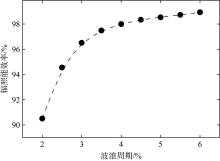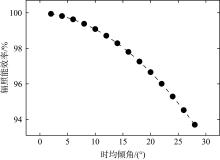| [1] |
陈正洪, 孙朋杰, 成驰, 等, 2013. 武汉地区光伏组件最佳倾角的实验研究[J]. 中国电机工程学报, 33(34): 98-105.
|
|
CHENG ZHENGHONG, SUN PENGJIE, CHENG CHI, et al, 2013. Experimental research on the optimal tilted angle for PV modules in Wuhan[J]. Proceedings of the CSEE, 33(34): 98-105 (in Chinese with English abstract).
|
| [2] |
高赟, 赵娜, 贺文山, 等, 2017. 水上光伏电站设计要点和经济性分析[J]. 太阳能, (6): 18-22 (in Chinese).
|
| [3] |
郭连贵, 2012. 太阳能光伏学[M]. 北京: 化学工业出版社 (in Chinese).
|
| [4] |
韩硕, 胡坚柯, 韩一峰, 等, 2023. 双面光伏组件建模及发电性能研究[J]. 太阳能学报, 44(9): 95-100.
|
|
HAN SHUO, HU JIANKE, HAN YIFENG, et al, 2023. Research on modeling and power generation performance of bifacial photovoltaic module[J]. Acta Energiae Solaris Sinica, 44(9): 95-100 (in Chinese with English abstract).
|
| [5] |
何啸, 2014. 海洋漂浮式光伏发电装置性能研究[D]. 宁波: 宁波大学: 1-63.
|
|
HE XIAO, 2014. Research of properties of ocean floating photovoltaic device[D]. Ningbo: Ningbo University: 1-63 (in Chinese with English abstract).
|
| [6] |
江娥, 2015. 武汉市光伏组件安装的最佳倾角分析[D]. 武汉: 武汉工程大学: 1-68.
|
|
JIANG E, 2015. An investigation on the optimum tilt angle of PV modules installed in Wuhan[D]. Wuhan: Wuhan Institute of Technology: 1-68 (in Chinese with English abstract).
|
| [7] |
金振逸, 马少杰, 2011. 基于线性波浪理论的海上浮动受力及运动分析[J]. 四川兵工学报, 32(8): 135-137 (in Chinese).
|
| [8] |
李华军, 刘福顺, 杜君峰, 等, 2022. 海洋工程发展趋势与技术挑战[J]. 海岸工程, 41(4): 283-300.
|
|
LI HUAJUN, LIU FUSHUN, DU JUNFENG, et al, 2022. Development trend and technical challenges of ocean engineering[J]. Coastal Engineering, 41(4): 283-300 (in Chinese with English abstract).
|
| [9] |
李克锋, 郝红升, 庄春义, 等, 2006. 利用气象因子估算天然河道水温的新公式[J]. 工程科学与技术, 38(1): 1-4.
|
|
LI KEFENG, HAO HONGSHENG, ZHUANG CHUNYI, et al, 2006. A new method for predicting water temperature of river by using meteorological factors[J]. Advanced Engineering Sciences, 38(1): 1-4 (in Chinese with English abstract).
|
| [10] |
廖东进, 黄志平, 方晓敏, 等, 2021. 双面光伏组件辐照度模型的研究[J]. 太阳能学报, 42(2): 471-476.
|
|
LIAO DONGJIN, HUANG ZHIPING, FANG XIAOMIN, et al, 2021. Analysis of solar radiation model for bifacial PV modules[J]. Acta Energiae Solaris Sinica, 42(2): 471-476 (in Chinese with English abstract).
|
| [11] |
鲁文鹤, 练继建, 董霄峰, 等, 2023. 波浪作用对海上漂浮式光伏光照辐照能的影响[J]. 水力发电学报, 42(5): 35-42.
|
|
LU WENHE, LIAN JIJIAN, DONG XIAOFENG, et al, 2023. Effect of sea waves on radiant energy of floating photovoltaic[J]. Journal of Hydroelectric Engineering, 42(5): 35-42 (in Chinese with English abstract).
|
| [12] |
牛高远, 王以笑, 龚晓伟, 等, 2016. 基于PVsyst的分布式并网光伏发电系统效率分析与优化研究[J]. 可再生能源, 34(2): 196-202.
|
|
NIU GAOYUAN, WANG YIXIAO, GONG XIAOWEI, et al, 2016. Study of efficiency analysis and optimization for distributed grid-connected photovoltaic power generation systems based on PVsyst[J]. Renewable Energy Resources, 34(2): 196-202 (in Chinese with English abstract).
|
| [13] |
邱文博, 李冠宇, 徐俊臣, 等, 2021. 黄渤海海域波浪时空变化特征分析[J]. 海洋科学, 45(7): 1-8.
|
|
QIU WENBO, LI GUANYU, XU JUNCHEN, et al, 2021. Spatial and temporal variation characteristics of the waves in the Yellow Sea and Bohai Sea[J]. Marine Sciences, 45(7): 1-8 (in Chinese with English abstract).
|
| [14] |
石文胜, 2020. 双面光伏发电系统的建模及最大功率点跟踪算法研究[D]. 保定: 河北大学: 1-67.
|
|
SHI WENSHENG, 2020. The research of fall prediction method based on surface electromyography[D]. Baoding: Hebei University: 1-67 (in Chinese with English abstract).
|
| [15] |
宋福龙, 陈晨, 张雯悦, 等, 2023. 省域水上光伏发电潜力分析评估方法及应用[J]. 全球能源互联网, 6(1): 33-44.
|
|
SONG FULONG, CHEN CHEN, ZHANG WENYUE, et al, 2023. Method for potential analysis and evaluation of water PV power generation within a province[J]. Journal of Global Energy Interconnection, 6(1): 33-44 (in Chinese with English abstract).
|
| [16] |
宋肖锋, 陈作钢, 肖福勤, 等, 2020. 漂浮式光伏电站方阵风载荷数值研究[J]. 太阳能学报, 41(10): 136-143.
|
|
SONG XIAOFENG, CHEN ZUOGANG, XIAO FUQIN, et al, 2020. Numerical research on wind load of floating solar power plants[J]. Acta Energiae Solaris Sinica, 41(10): 136-143 (in Chinese with English abstract).
|
| [17] |
孙杰, 2017. 水上光伏电站应用技术与解决方案[J]. 太阳能, (6): 32-35 (in Chinese).
|
| [18] |
肖福勤, 陈作钢, 代燚, 等, 2020. 漂浮式光伏电站方阵环境载荷计算方法研究[J]. 工程力学, 37(3): 245-256.
|
|
XIAO FUQIN, CHEN ZUOGANG, DAI YI, et al, 2020. Numerical method study on environmental loads of floating photovoltaic power array[J]. Gineering Mechanics, 37(3): 245-256 (in Chinese with English abstract).
|
| [19] |
张木梓, 王艺澄, 2020. 全球水上光伏产业的发展现状及市场前景分析[J]. 太阳能, 7: 19-24.
|
|
ZHANG MUZI, WANG YICHENG, 2020. Global floating PV industry development status and market prospect analysis[J]. Solar Energy, (7): 19-24 (in Chinese with English abstract).
|
| [20] |
中华人民共和国住房和城乡建设部, 2012. 光伏发电站设计规范: GB50797-2012[S]. 北京: 中国计划出版社 (in Chinese).
|
| [21] |
卓自想, 段士伟, 任静, 2023. 武汉地区光伏电站理论年发电量的计算研究[J]. 太阳能, 347(3): 30-37.
|
|
ZHUO ZIXIANG, DUAN SHIWEI, REN JING, 2023. Research on calculation of theoretical annual power generation capacity of PV power stations in Wuhan region[J]. Solar Energy, 347(3): 30-37 (in Chinese with English abstract).
|
| [22] |
CHARLOTTE B, PETER T, JENS P K, et al, 2011. A methodology for production and cost assessment of a farm of wave energy converters[J]. Renewable Energy, 12(36): 3402-3416.
|
| [23] |
DURUSOY B, OZDEN T, AKINOGLU B G, 2020. Solar irradiation on the rear surface of bifacial solar modules: a modeling approach[J]. Scientific Reports, 10: 13300.
|
| [24] |
LIU B Y H, JORDAN R C, 1960. The interrelationship and characteristics and distribution of direct, diffuse, and total solar radiation[J]. Solar Energy, 4(3): 1-19.
|
| [25] |
PADOVAN A, DEL COL D, 2010. Measurement and modeling of solar irradiance components on horizontal and tilted planes[J]. Solar Energy, 84(12): 2068-2084.
|
| [26] |
PAN YUANCHAO, DAI ZHUHANG, MA HAOXIANG, et al, 2024. Self-powered and speed-adjustable sensor for abyssal ocean current measurements based on triboelectric nanogenerators[J]. Nature Communications, (15): 6133.
|
| [27] |
REFAAI M R A, DHANESH L, GANTHIA B P, et al, 2022. Design and implementation of a floating PV model to analyse the power generation[J]. International Journal of Photoenergy, ( 2022): 1-13.
|
| [28] |
SHI WEI, YAN CHAOJUN, REN ZHENGRU, et al, 2023. Review on the development of marine floating photovoltaic systems[J]. Ocean Engineering, 286(1): 115560.
|
| [29] |
SUN XIN, SHANGCHENJING, MA HAOXIANG, et al, 2022. A tube-shaped solid-liquid-interfaced triboelectric-electromagnetic hybrid nanogenerator for efficient ocean wave energy harvesting[J]. Nano Energy, (100): 107540.
|
| [30] |
XU QINGYUE, SHANG CHENJING, MA HAOXIANG, et al, 2023. A guided-liquid-based hybrid triboelectric nanogenerator for omnidirectional and high-performance ocean wave energy harvesting[J]. Nano Energy, (109): 108240.
|
 ), CHAO Gang, XU Qingyue, WEI Pengchong
), CHAO Gang, XU Qingyue, WEI Pengchong









